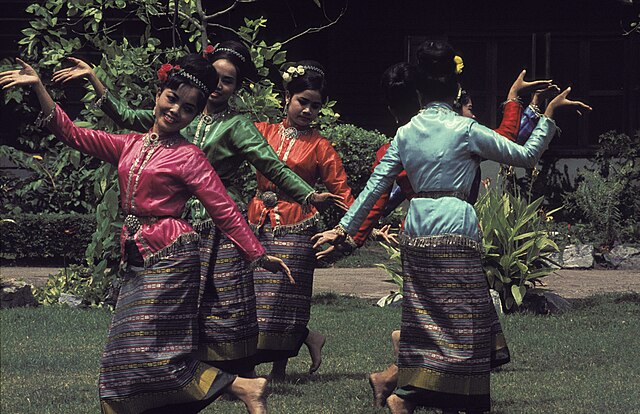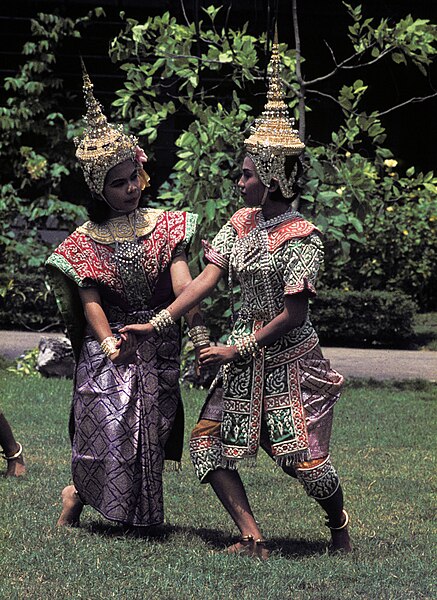
Thammasat University students who are interested in the performing arts, dance, Thai studies, sociology, culture, folklore, and related subjects may find a newly acquired book useful.
Lives in Motion: Celebrating Dance in Thailand is coedited by Professor Pornrat Damrhung of the Faculty of Arts, Chulalongkorn University.
The TU Library collection includes several books about different aspects of dance in Thailand.
The publisher’s description of the new book:
Lives in Motion celebrates dance in Thailand, focusing on the diversity of Thailand’s dance cultures and their place in today’s world. Giving voice to eminent artists and scholars on the complex roles that Thailand is pursuing for artful movement at home and abroad, the book provides key perspectives on Thai dance traditions and practitioners. It explores the many forms and meanings in contemporary dance, changing local traditions in the country, the evolution of Thai dance on the global stage, and hybrid features of the Thai dance world.
The book examines how hybridity has been integral to dance cultures in Thailand and discusses how they have actively adapted and negotiated their knowledge in relation to modernity and globalization. Developing new models, standards and sites for dance, movement and theater, dance in Thai has been advancing in innovative ways, whether it is to include fresh forms of skilled bodily movement or to expand in new arenas like tourism and online platforms. Similarly, old systems of training, which included artists’ homes, palaces, and temples, have been adapted into the new world of modern education, media, home schooling, and new community rituals.
A pioneering contribution on Thai performing arts, this volume examines contemporary Thai dance cultures in the local, national, regional, and global contexts. It will be of great interest to scholars and researchers of dance and performance studies, cultural studies, Southeast Asia studies, and art.
The book’s introduction presents
an overview of the key concepts discussed in the subsequent chapters of this book. The book focuses on lives in motion and embodying community through corporeal movement is one aspect of critical Thai studies and critical dance studies. It provides an array of definitions that can be compared with one another, thereby allowing readers to identify a range of possibilities that suit diverse directions made by different analyses. The book examines several examples of vernacular dance cultures in Central Thailand and explores how they were affected by the COVID-19 pandemic and how they have reemerged in the post-pandemic era. It also examines how dance tied to Morlam traditions of performance and healing in Isan have been reimagined as part of new modern dance assemblages for the public called Rum Buang Suang, whether to worship Naga serpent spirits or to celebrate urban cultural heritage with tens of thousands of Isan dancers.

A chapter, Remembering Contemporary Thai Dance with an Eye to Its Futures by Professor Surapone Virulrak notes:
Contemporary dance in Thailand is not new, but is part of a long and ongoing evolution involving both local and global dimensions and developments. Picking up some threads of this evolution, this chapter will consider several specific examples of “contemporary dance” that were formative in establishing the current Thai dance landscape, focusing on those that the author was involved with. Doing this will permit us to better see how “contemporary dance” has been a moving target, in part because those involved in it have different visions of the significance of dance. Another aspect that emerges from this chapter is the relation between contemporary dance as a practice and a product for artists, which occupied the author when he was younger, and the perspective offered by that of building the institutions and infrastructure within which contemporary dance can emerge, evolve, critique, and sustain itself, which now concerns the author more. Both perspectives and dimensions are important for the survival of contemporary dance.

A further chapter by Professor Pornrat, Unseen Thailand: Exploring the Hidden Lives of Dance in Contemporary Thai Culture, observes:
Although skilled bodily movement is integral to Thai culture, professional dance sometimes seems hard to find in the kingdom. To think about this seeming contradiction, this chapter will develop some perspectives and explore some examples on the place of minor forms of dance in contemporary Thai culture. Rhythmic bodily moves are pervasive in Thai life, but they often go unmarked as art, leaving them underappreciated as dance. Amid a changing Thai society, much of what is credited as “contemporary dance” in Thailand has come to be dominated by either those who mastered the refined elegance of various Thai traditional dance forms or those who disciplined themselves in dance disciplines rooted in the West. While this has devalued much of the cultures of movement outside of these two versions of contemporary dance on the national stage, such forms of movement remain common to homes, communities, and temples, and are key to identities performed in local, less visible, and amateur patterns of movement. The emergence of new media and a kind of “dance or else” attitude helped these forms of minor dance to proliferate, whether as bodily memories, community identities, or struggles for cultural recognition. Communities in urban and rural areas see dance as key to engaging young, old, and local artists and amateurs in events for celebrating Thai bodies in motion. Although the COVID-19 pandemic disrupted many patterns and forms of vernacular movement, they found new viral forms of performing and sharing their work, and since late 2021 have begun to reemerge in new co-present and online venues.

A further study, A Glocalized Tradition: Worldly Currents of Nora in Southern Thailand is by Dr. Kanit Sripaoraya, who studied Cultural Management at the College of Innovation, Thammasat University (CITU) and is now affiliated with the Faculty of Creative Technology and Heritage at the University of Malaysia, Kelantan, a public university in Kelantan, Malaysia.
She explains:
This chapter will explore some current trends of Nora performance culture in southern Thai communities. Working beyond Nora ritual performances for ancestral worship and entertainment, performances have become embedded in dance schools and university curricula. This has helped to make Nora both more popular and become recognized as a key aspect of southern Thai cultural identity. Nora has been reshaped, reformed, and rechoreographed to fulfill community needs dynamically within contemporary contexts. Both Nora masters and the Thai Culture Ministry now normally distinguish two types of Nora performance: ritual Nora done for a Nora family’s lineage and entertainment Nora for public audiences. While focusing on the former type, the chapter will examine several case studies of Nora entertainment to show some ways that Nora in southern Thailand has adapted to contemporary contexts and global processes: (1) intensive Nora classes have shortened the process of traditional learning to —one- to two-hour weekly classes; (2) new choreography for contemporary and creative Nora; (3) business Nora. Together, these cases show how Nora masters use their social networks and media as platforms to promote their dance troupes and to collaborate or create translocal networks with one another.

(All images courtesy of Wikimedia Commons)
